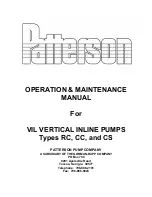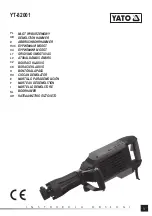
www.pulsar.pl
PSBS10A12E
7
Operation safety (tab.5).
Protection class PN-EN 60950-1:2007
I (first)
Protection grade PN-EN 60529: 2002 (U)
IP20
Electrical strength of insulation:
- between input (network) circuit and output circuits of the PSU (I/P-O/P)
- between input circuit and PE protection circuit (I/P-FG)
- between output circuit and PE protection circuit (O/P-FG)
3000 V/AC min.
1500 V/AC min.
500 V/AC min.
Insulation resistance:
- between input circuit and output or protection circuit
100 MΩ, 500V/DC
Operating specifications (tab.6).
Operating temperature
-10ºC...+40ºC
Storage temperature
-20ºC...+60ºC
Relative humidity
20%...90%, without condensation
Vibrations during operation
unacceptable
Impulse waves during operation
unacceptable
Direct insolation
unacceptable
Vibrations and impulse waves during transport
PN-83/T-42106
2. Installation.
2.1 Requirements
The buffer PSU is to be mounted by a qualified installer, holding relevant permits and licenses (applicable
and required for a given country) for 230V/AC interference and low-voltage installations. The unit should be
mounted in confined spaces, in accordance with the 2nd environmental class, with normal relative humidity
(RH=90% maximum, without condensation) and temperature from -10°C to +40°C. The PSU shall work in a vertical
position that guarantees sufficient convectional air-flow through ventilating holes of the enclosure.
The PSU supplies voltage of
13,8 V DC
with current efficiency of:
1. Output current 10A (without a battery)
2. Output current 9,3A + 0,7A battery charge
3. Output current 7,9A + 2,1A battery charge
4. Output current 6,4A + 3,6A battery charge
5. Output current 5,2A + 4,8A battery charge
Total current of the rec battery: 10A max.
As the PSU is designed for a continuous operation and is not equipped with a power-switch, therefore an
appropriate overload protection shall be guaranteed in the power supply circuit. Moreover, the user shall be
informed about the method of unplugging (most frequently through separating and assigning an appropriate fuse in
the fuse-box). The electrical system shall follow valid standards and regulations.
2.2 Installation procedure.
1. Before installation, make sure that the voltage in the 230V power-supply circuit is cut off.
2. Mount the PSU in a selected location and connect the wires.
3. Connect the power cables (~230Vac) to L-N terminals of the PSU. Connect the ground wire to the terminal
marked by the earth symbol – “
” on the plate. Use a three-core cable (with a yellow and green PE protection
wire) to make the connection. Lead the cables to the appropriate terminals of the connection board through the
bushing.
The shock protection circuit shall be performed with a particular care, i.e. the yellow and
green wire coat of the power cable shall stick to one side of the terminal marked with the ‘
’
earth symbol in the PSU enclosure. Operation of the power supply without a properly made
and fully operational shock protection circuit is UNACCEPTABLE! It can result in device
damage or an electric shock.
4. Connect the receivers’ cables to the +AUX-, +AUX1-, +AUX2-, +AUX3- connectors of the terminal block on the
PSU board.
5. If necessary, connect the devices’ wires to the technical outputs:




























